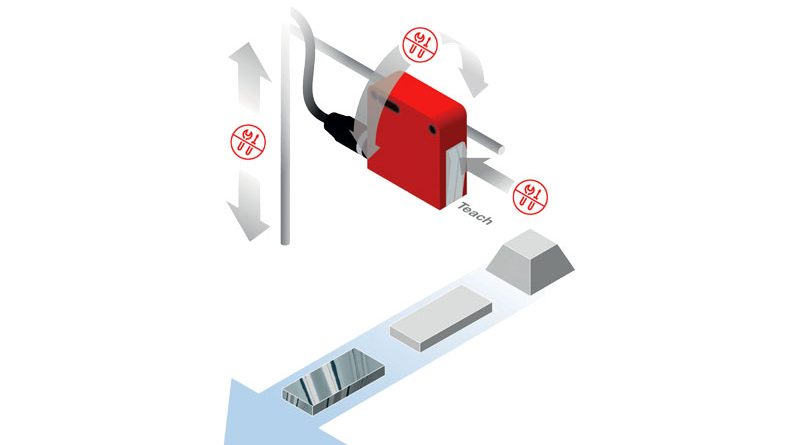The Sensor Becomes Intelligent
If the object can change at any time, use its environment instead as a constant reference surface: this is the underlying idea of the dynamic reference diffuse sensor from Leuze, which works with conveyor belts
The DRT 25C dynamic reference diffuse sensor from Leuze is based on the CAT technology (Contrast Adaptive Teach), which transforms a simple diffuse sensor into a highly intelligent device. Here is the mode of operation: it is taught in on a reference surface at the press of a button on which it can then reliably detect nearly every object – independent of shape, color and surface structure. Serving as the reference surface is anything available in the given application environment, such as a machine wall, a piece of sheet metal, or even a vibrating, moving conveyor belt. This makes the sensor particularly well suited for use in packaging systems, especially in the area of confectionery and baked goods. No readjustment is necessary when changing objects.
Clever sensor: the evolution is going on
Leuze developed its first own optical sensor almost 60 years ago. Numerous technological solutions have followed since then, such as the Sensor People: the range includes different sensors for the field of automation technology, with an in-depth application know-how in their specific focus industries. One of these is the packaging industry, which, with throughputs of several hundred thousand products per day and finely tuned process steps, places extremely high demands on the optical sensors. Clear-glass retro-reflective photoelectric sensors require less maintenance through smart tracking. Thanks to line-shaped light spots, laser diffuse sensors detect objects – no matter how complex – on their front edge. Throughbeam photoelectric sensors detect the chocolate bar in its outer packaging with completely harmless infrared light. The intelligent CAT technology, which the new DRT 25C dynamic reference diffuse sensor uses, continues the idea of the clever sensor.

The wide scanning range detects even products with complex geometries. 
It is possible to detect packaging with a wide range of colors and transparency.
The vibrating conveyor belt serves as a teachable reference
Packaging and the objects to be packaged vary widely in color, shape and surface structure: flat, glossy, with openings or transparent – the entire spectrum. As a result, they are not so easy to detect. But precisely that is the task of optical sensors in packaging systems.
The challenge in object detection is in detecting as quickly and reliably as possible and ideally directly from above. At the same time, the working environment poses a challenge as well: the objects that are to be detected are usually on conveyor belts that move and vibrate and which may become soiled or wet. This requirement led to the development of the CAT technology at Leuze. The underlying idea is simple: if the object can change at any time, use its environment instead as a constant reference surface. In packaging systems, this is the conveyor belt. This serves as a teachable reference. Once the sensor has been taught the contrast information of the conveyor belt, it only needs to be intelligent enough to adapt this knowledge to a possible change of environment. This is precisely what CAT technology does.
Once the sensor has been “taught” no readjustments are necessary
The new DRT 25C uses the CAT technology in a new operating principle: it learns the signal parameters of the conveyor belt at the press of a button and stores them as the “standard zero”. Every object that is transported on the conveyor belt now generates a signal. If this deviates from the zero state, the DRT 25C reliably detects the object as a “deviation from the reference”. The performance of the device is optimized through the choice of teach level. There is, for example, a teach routine for conveyor belts that become heavily soiled over time. Another teach level exists especially for the detection of very flat or even transparent objects. Once the sensor has been “taught”, no additional settings or readjustments are necessary. Not even if the object is changed, as the sensor operates together with the conveyor belt as a reference.
Operating reliably even with difficult shapes and surfaces
If, for example, a chocolate bar is not reliably detected, a mishap quickly occurs in the subsequent, precisely cycled packaging, which must then first be removed and cleaned. The more reliably the sensor detects the product, the less frequent unplanned maintenance needs to be performed. Herein lies the strength of the DRT 25C, which operates reliably even with difficult shapes and surfaces. This increases the machine throughput, the production quantity and avoids downtime. Because no adjustment work needs to be performed on the sensor when changing products or changing the packaging materials, setup time is also reduced. Thanks to the DRT 25C that uses the conveyor belt as a reference, sensors don’t have to be readjusted when a format changes – such as from the classic 100 g bar of chocolate to a mini chocolate cube. Even if the color, height or contour of the packaging changes, no settings need to be made at all on the dynamic reference diffuse sensor.

